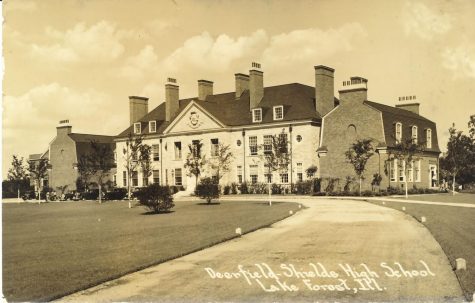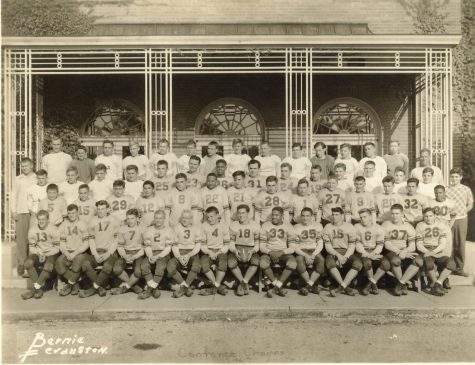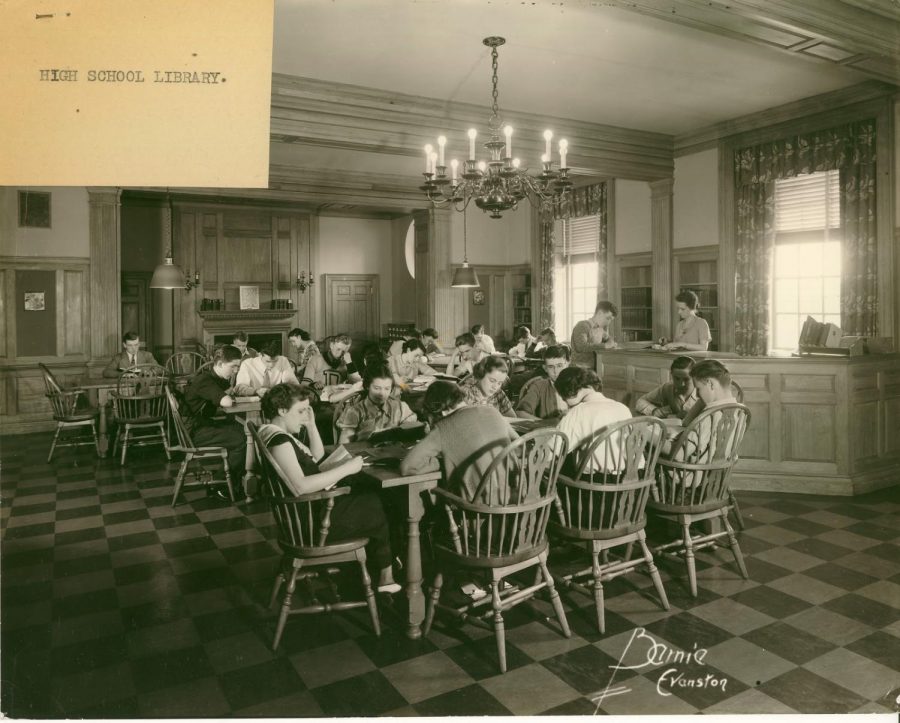Students working in the Publick Room
Opening of LFHS
As many students know, Lake Forest High School first opened its doors in 1935.
Before the school was built, most upper-class families decided to send their children to boarding schools on the east coast. The middle and lower class children of Lake Bluff and Lake Forest attended the closest public school – Deerfield High School.
There were multiple points in time during which the two towns considered joining Deerfield Township, as this would increase property value in the towns and draw in new families due to the access to Deerfield High School. The school was still a part of Deerfield Township when it was built. It wasn’t until their third attempt to split from Deerfield in 1949 when the towns were able to have full control over the decisions pertaining to LFHS.

This explains why the crest above the front door states “Deerfield Township” – LFHS was an offset of DHS.
There were a couple of reasons why LFHS was constructed. First, as Lake Forest continued to grow in population, the need for a local public school grew as well. Additionally, the Great Depression. There were many jobless citizens across the country, and even though it’s true that Lake Forest was in better shape than most communities during this time, no one was completely isolated from its devastating financial effects.
The Depression in 1934 increased the number of families who wanted to send their children to public school as opposed to the expensive prep schools. After seeing this need emerge rapidly, the community started making plans for the school.
A common misconception among current students is that the high school was originally the home of a wealthy family. This stems from how the architect Stanley D. Anderson designed the high school to resemble an estate: they didn’t want to disrupt the landscape of the community. Something that is very odd about the high school is that it was paid for with federal funds.
As one might assume, some members of the town were ashamed of this – they didn’t want it to seem as though they couldn’t pay for the construction themselves. However, the community was very proud of the high school when it was finished. At the time of the completion, some called it one of the finest high schools in the country. It represented an advancement in the two towns.

There were only 389 students who attended LFHS in its first year. During the first handful of years that the high school was in operation, the schedule consisted of six periods, plus advisory and lunch. The passing periods were four minutes, and the day ran from 8:45 A.M. to 3:45 P.M. The advisories were called “homeroom sessions”, and were split by gender. The advisors of each session had the same responsibilities as those of our current counselors. Sessions would compete against each other in basketball, baseball, and field hockey games on the front lawn. During the week of Homecoming, these sessions would also make floats to ride on in the parade. In 1942, these sessions became co-ed.
Originally, LFHS’ mascot was the “Goldcoasters.” It wasn’t until the students felt that this name was unfitting that they conducted a vote to change the mascot to the Scouts – however, the mascot originally was NOT a representation of Native Americans.
David Adler, a highly-lauded architect who designed many well-known estates on the North Shore designed the senior star in the front hallway on the first floor. If a freshman stepped on the Senior Star, they would have to scrub it clean with a toothbrush. The current mascot was brought up around the idea of this star. The star represented a compass that pointed the way out of the “forest” for all of the Scouts inside of the school. If you learn anything from this article, let that fact be the one you take with you.
